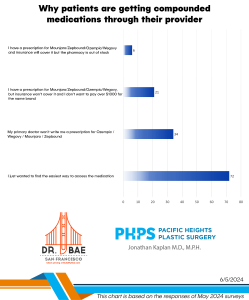I attended a lecture this evening for the dermatologists and plastic surgeons in the area on the topic of fillers. Fillers, as you may or may not know, are injections used to enhance a variety of areas in the face that contribute to the appearance of facial aging. Fillers were originally used to just fill in deep creases like the “parentheses” lines that extend from the nose down to the corners of the mouth, but now can be used to volumize areas of the face, not just lines. For example, in addition to filling in lines, they can be used to plump up the cheek bones or volumize the area under the eyes to correct dark circles. Overall, it was a very interesting presentation followed by a demonstration on a willing patient volunteer.

And while the lecturer who performed the injections was very good and clearly competent, they were guilty of a pet peeve of mine. Injections into the face with fillers that have a slightly thick consistency, tend to hurt. It’s not discomfort, it’s not another euphemism for pain – it’s just plain pain. But fillers don’t have to hurt!
Dr. Zins, my chairman at the Cleveland Clinic during my plastic surgery fellowship, taught me something that I thought everyone did at the time. He performed dental blocks on patients before he injected filler into their face. SImilar to what a dentist does before dental work, you take lidocaine/xylocaine and inject it into the mouth. This has the effect of numbing the entire middle part of the face, which is the part of the face where fillers are used. So if you inject the numbing medicine (which hurts a lot less than you’d think and certainly hurts less than injecting fillers without a dental block) before injecting fillers, the patient has no pain. None whatsoever. No pain when injecting the parentheses lines and no pain when injecting the lips.
Patients that come to me for injections after having injections by another doctor in the past, are always shocked at how pleasant the experience is when I perform a dental block. They describe that the pain didn’t seem so bad with the previous filler injection but after experiencing NO PAIN with my dental block, they start to realize how painful it really was “that other time.” I’m not really sure why doctors, dermatologists and plastic surgeons alike, don’t perform dental blocks. Maybe because they didn’t have a Dr. Zins teach them how to? But there’s no rationalization for not doing it. As doctors, we’re supposed to do no harm. This is a perfect example of a technique that’s available to avoid causing our patients pain.
Doctors that don’t do dental blocks often use the same excuse. They explain that there’s less pain because they first mix the filler with lidocaine. But when you do it this way, rather than injecting the numbing medicine first, the patient still feels the pain of the filler injection since the lidocaine wasn’t injected earlier. They still feel the needle stick from the filler. And when you wait to mix the lidocaine with the filler, the patient only starts to get numb a few minutes after you’ve been injecting this painfully thick filler into their face!
Again, dermatologists and plastic surgeons are well trained to provide fillers for your facial rejuvenation but when you call to book your appointment, ask if the doctor does a dental block before the filler injection. If they don’t or they say they mix the filler with lidocaine or they use a topical, don’t schedule – it’ll still hurt and fillers, when used with a dental block, don’t have to hurt!
Click here for the original blog post written by Dr. Jonathan Kaplan for BuildMyBod.




